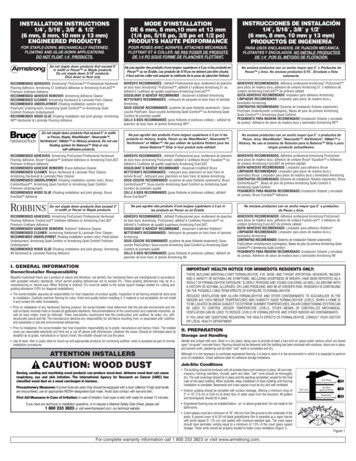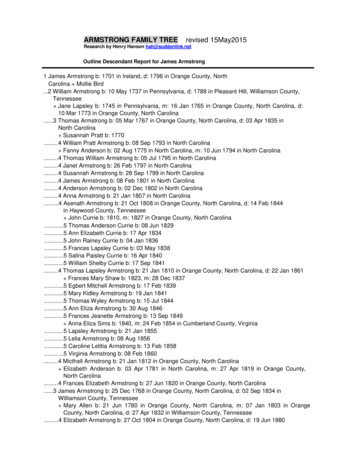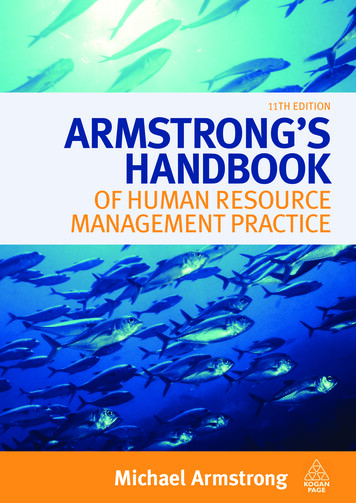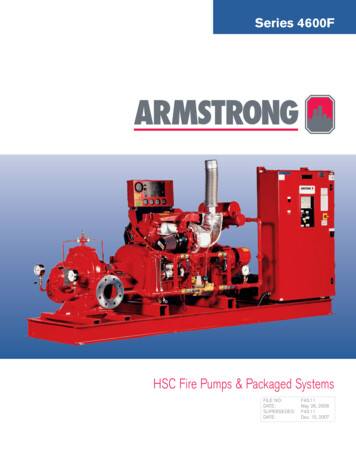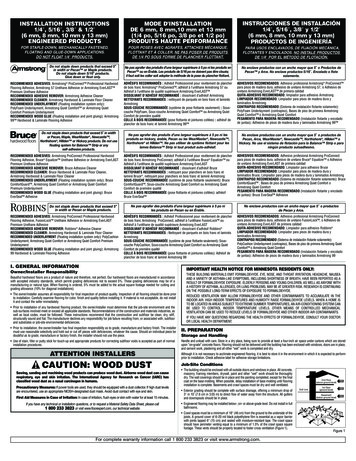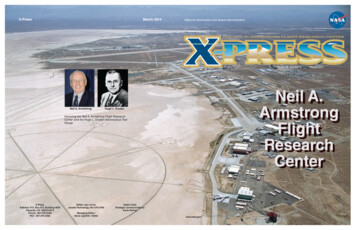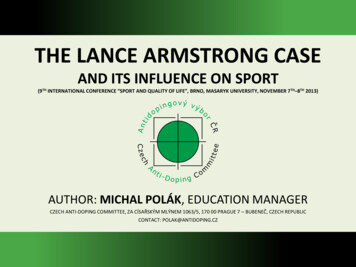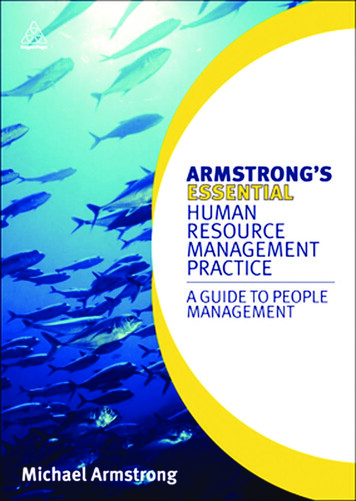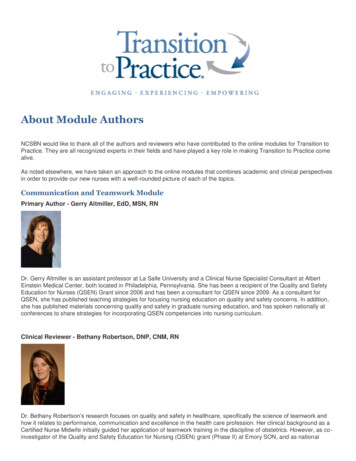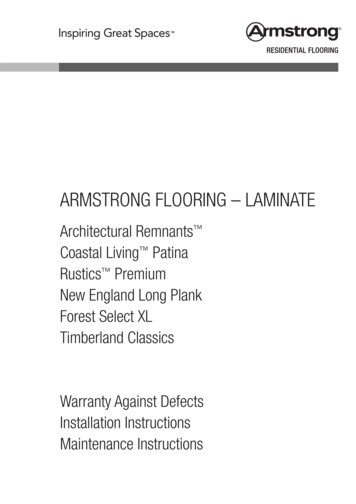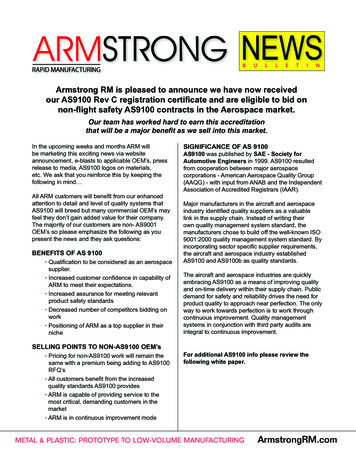
Transcription
Armstrong RM is pleased to announce we have now receivedour AS9100 Rev C registration certificate and are eligible to bid onnon-flight safety AS9100 contracts in the Aerospace market.Our team has worked hard to earn this accreditationthat will be a major benefit as we sell into this market.In the upcoming weeks and months ARM willbe marketing this exciting news via websiteannouncement, e-blasts to applicable OEM’s, pressrelease to media, AS9100 logos on materials,etc. We ask that you reinforce this by keeping thefollowing in mind All ARM customers will benefit from our enhancedattention to detail and level of quality systems thatAS9100 will breed but many commercial OEM’s mayfeel they don’t gain added value for their company.The majority of our customers are non- AS9001OEM’s so please emphasize the following as youpresent the news and they ask questions:BENEFITS OF AS 9100 Qualification to be considered as an aerospacesupplier. Increased customer confidence in capability ofARM to meet their expectations. Increased assurance for meeting relevantproduct safety standards Decreased number of competitors bidding onwork Positioning of ARM as a top supplier in theirnicheSIGNIFICANCE OF AS 9100AS9100 was published by SAE - Society forAutomotive Engineers in 1999. AS9100 resultedfrom cooperation between major aerospacecorporations - American Aerospace Quality Group(AAQG) - with input from ANAB and the IndependentAssociation of Accredited Registrars (IAAR).Major manufacturers in the aircraft and aerospaceindustry identified quality suppliers as a valuablelink in the supply chain. Instead of writing theirown quality management system standard, themanufacturers chose to build off the well-known ISO9001:2000 quality management system standard. Byincorporating sector specific supplier requirements,the aircraft and aerospace industry establishedAS9100 and AS9100b as quality standards.The aircraft and aerospace industries are quicklyembracing AS9100 as a means of improving qualityand on-time delivery within their supply chain. Publicdemand for safety and reliability drives the need forproduct quality to approach near perfection. The onlyway to work towards perfection is to work throughcontinuous improvement. Quality managementsystems in conjunction with third party audits areintegral to continuous improvement.SELLING POINTS TO NON-AS9100 OEM’s Pricing for non-AS9100 work will remain thesame with a premium being adding to AS9100RFQ’s All customers benefit from the increasedquality standards AS9100 provides A RM is capable of providing service to themost critical, demanding customers in themarket ARM is in continuous improvement modeFor additional AS9100 info please review thefollowing white paper.Metal & Plastic: Prototype to Low-Volume MANUFACTURINGArmstrongRM.com
White PaperAS9100CAn Overview of the AS9100Revision C Aerospace and DefenseQuality Standard and How it CanBenefit Your OrganizationExcellence. Assured.
2Table of Contents2Background to AS9100:20093AS9100C - The Updated Standard5AS9100C - The Benchmark for Aerospace Quality7What’s Happening in theAerospace Industy?9SummaryBackground to AS9100:2009 Revision C– The Next Level of Aerospace CertificationEarly in 2009, the IAQG released Revision C to AS9100, the aerospace quality management system (QMS) standard. This revision marks the first significant change to the standard since its initial release. AS9100 Series standards are maintained and harmonizedthrough the workings of the IAQG and are recognized worldwide. The IAQG is composedof OEMs & prime suppliers across the Americas, European and Asia-Pacific sectors.The process of rewriting AS9100 started back in 2005 by gathering stakeholder input.These stakeholders included civil aviation authorities, defense and space authorities,certification bodies, trade associations, suppliers and IAQG member companies. Theinput came in the form of comments and each comment (approximately 350) had to beaddressed as part of the process.Based on this stakeholder input and the IAQG Charter, the re-write team was given fivekey objectives:1.2.3.4.5.Incorporate the ISO 9001:2008 base requirementsExpand the scope from an aerospace standard to an aviation,space and defense standardEnsure alignment with IAQG strategies for on-time, on-quality deliveryIncorporate new requirements based on the needs of stakeholdersImprove existing requirements based on needs identified by stakeholdersRevising this standard entailed a process of survey, discussion and review, which due tothe broad and international nature of stakeholders took several years to complete. Theoutcome is a valuable standard applicable to a wider array of complex systems heavily dependent on international networks of suppliers throughout the supply chain. It issuitable to be used by all sizes of organizations engaged in the various levels of productcomplexity and is no longer just an “aerospace standard”, but an “aviation, space anddefense” standard.SAI GLOBAL Assurance Services AS9100Cwww.saiglobal.com/assurance
AS9100C:To gain anunderstanding ofwhat has changedin AS9100C, Wecan considerthe changes asbeing an Addition,Revision or aDeletion3The Updated StandardKey Additions: There have been six key additions during this revision.(Note that these are only the KEY changes and many more minor changes were madeduring the revision process)Addition #1 – The term Risk was introduced and is now mentioned throughout thestandard from system planning to contracts, to supply chain management and throughplanning and production. An organization must be able to identify risks, manage them andhave risk mitigation plans in place. Risk has been defined as, “An undesirable situationor circumstance that has both the likelihood of occurring and a potentially negativeoutcome.” Understanding risk is important in developing a proactive aerospace QMS.Addition #2 – The term Special Requirements has been added and defined as, “ThoseRequirements that have a high risk of being achieved, thus requiring their inclusioninto the risk management process.” Factors used to determine special requirements areproduct or process complexity, past experience and/or product or process maturity. It willbe important to understand the potential flow from special requirements to critical itemsand/or key characteristics.Addition #3 – The term Critical Item has been added and defined as, “Those items havingsignificant effect on product realization and the use of products that require specificactions to ensure they are managed.” Organizations will need to understand critical itemscoming from special requirements and ensure they are systematically addressed and linkedto risk management.Addition #4 – Customer Focus/Satisfaction (ref clause 5.2/8.2.1) – This is a newrequirement that requires on-time delivery and product quality be measured, as well asappropriate actions put into place when customer objectives are not met. The evaluation ofcustomer satisfaction shall include monitoring of product conformity, delivery performance,complaints, or corrective action requests. This requirement will establish a clearrelationship between the QMS and organizational performance.Addition #5 – Project Management (7.1.1) – A new requirement for planning andmanaging product realization in a structured and controlled way. Most aerospace productsare complex and involve multi-tier partners and suppliers. Organizations will need to havea process to manage product realization to ensure quality and that schedules are notcompromised.Addition #6 – Risk Management (7.1.2) – This new requirement under clause 7.1 is riskmanagement. It requires an organization to implement a risk management process. Thisclause will require organizations to identify and classify risk, determine levels of acceptablerisk for the organization and have effective risk mitigation plans for unacceptable risk. Thisrequirement puts a focus on product risk during product realization. This is vital as newtechnologies in aircraft, space vehicles, defense systems and materials are introduced.Organizations will need to ensure a risk management process is in place and that the risksare appropriately applied in the process and that they are successfully managed.SAI GLOBAL Assurance Services AS9100Cwww.saiglobal.com/assurance
4Key Revisions: There have been eight key revisions during this process.Revision #1 - The scope of the standard was revised so that it incorporated the defenseindustry as well as aviation and space (aerospace). The basis for this broadening was that aQMS suitable for aviation and space would also be applicable to the defense industry dueto the complex nature of systems and the prevalence of international supply chains.Revision #2 - QMS General Requirements – The organization’s QMS shall addresscustomer and applicable statutory and regulatory QMS requirements. The concept of basicQMS can be used, but the documents such AS9100C: The Updated Standard 2as quality management plans, which addresses specific customers’ requirements, shall beconsidered as part of the QMS.Revision #3 - Configuration Management (7.1.3) – The existing configuration managementclause was simply moved from section 4 to section 7. This puts the focus on productinstead of documentation. Some level of configuration management is expected for allproducts at all levels of the supply chain.Revision #4 – Work Transfer (7.1.4) – The existing work transfer clause was moved fromsection 7.5 to 7.1 and expanded to cover permanent transfer from one organization toanother. A process must exist to control the transfer of work, including planning andsubsequent control of the transfer.Revision #5 - Recognition of Supplier Quality Data (7.4.1) – This change is in the formof a guidance note that encourages the use of data from external sources in the supplierselection/evaluation process. The Industry trend is to use externally provided supplierperformance data (e.g. OASIS).Revision #6 - Approval Status of Suppliers (7.4.1) – This will require organizations todefine the various status levels they use along with the scope of approval for each. Theywill also have to define the process for supplier approval status decisions and changes.This requirement stems from the increased emphasis on supply chain managementthroughout the aerospace industry. Conditions for using a supplier must depend on theapproval status and an organization must be able to demonstrate the logic used in makingthose decisions. Process, responsibilities and authorities must be defined.Revision # 7 - Production Process Validation (7.5.1.1) – This change basically moves theFirst Article Inspection requirement from clause 8.2.4. It will require organizations toverify the production processes, documentation and tooling are capable of producing partsand assemblies that meet requirements. AS9102 will still be referenced as the guidanceand is often flowed down from major aerospace companies.Revision #8 - Sampling Inspection (8.2.4) – The revision is that, when the organizationuses sampling inspection as a means of product acceptance, the sampling plan shallbe justified on the basis of recognized statistical principles and appropriate for use. Therationale was that numerous requests were received to improve the sampling clause andthe way it was previously written confined organizations under other plans that could stillbe proven statistically valid.SAI GLOBAL Assurance Services AS9100Cwww.saiglobal.com/assurance
5Key Deletions: There have been three key deletions during this revision.Deletion #1 - Quality Manual Relationships (4.2.2) – This change deleted the previousrequirement to create a document showing the relationship between AS9100 requirementsand the organization’s documented procedures. The stakeholder input received duringthe revision process was that this requirement had no impact on product quality and wasviewed as prescriptive.Deletion #2 - Validation of Test Reports (7.4.3) – The previous revision required organizations to periodically validate test reports for raw material. This was often a misunderstoodconcept, frequently misapplied and viewed as prescriptive and subject to varying interpretations. The rationale going forward will be that if an organization is making critical items,where the material chemical and physical requirements are important, they should beverifying test reports as part of the risk management process.Deletion #3 - Detailed Tools and Techniques (8.2.2) – This change removed the requirement for organizations to use detailed tools and techniques such as check sheets, flowcharts, etc. to support the internal audit process. Industry considered this to be too prescriptive and decided it was best to leave the identification of tools up to the supplier.AS9100 - The Benchmark for Aerospace QualityThe benefits ofcertification toAS9100 candeliver a positiveimpact to yourorganization’s ROIwith heightenedcustomersatisfaction.Not Yet AS9100 Certified?Certification to AS9100 can enable an organization to realize the processes requiredto realize a sustainable Aerospace Quality Management System (AQMS) with improvedperformance measures in quality, delivery and costs. Ultimately, these benefits can delivera positive impact to your organization’s return on investment (ROI) with heightenedcustomer satisfaction.Within the aerospace industry, companies have little choice on whether or not to establisha QMS. The Federal Aviation Administration (FAA) defines individual manufacturingapprovals through its Federal Aviation Regulations (FARs) and laws mandating compliance.Companies can choose to implement a QMS that exceeds FAA requirements. That choiceis rapidly becoming a prerequisite for doing business because many aerospace OEMs aredemanding that suppliers be certified to the new AS9100 quality standard.AS9100 Quality Management Systems - Requirements for Aviation, Space and DefenseOrganizations focuses on aerospace requirements that support the FAA’s FAR Title 14 Part21 requirements. Safety, airworthiness, product conformity and reliability are key aspects.These quality requirements are crucial to aerospace OEMs, which maintain a high levelof liability for their product. Suppliers must also demonstrate superior performance tosucceed in today’s competitive and cyclical aerospace market.SAI GLOBAL Assurance Services AS9100Cwww.saiglobal.com/assurance
6A Foundation for SuccessAS9100 is based on ISO 9001:2008 but with approximately 100 additional requirementsspecific to aerospace. AS9100 provides suppliers with a comprehensive quality systemfocused on areas directly impacting product safety and reliability, including: Configuration Management – requires that a management discipline be appliedover the life cycle of a product to provide visibility and control of its functionaland physical characteristics Design – ensures that design responsible organizations have a robust designprocess to meet safety and reliability requirements demanded by the aerospaceindustry Purchasing – requires effective controls over the organization’s entire supply chain Product Realization – ensures that each phase of product realization, fromplanning to shipment, is tightly controlled for delivery of conforming products Product Monitoring/Measurement – that defines requirements for productvalidation prior to shipmentOther technical additions that relate to product safety, reliability and maintenance include: Regulatory RequirementsQuality Requirements Flow DownsFirst Article InspectionPositive RecallAerospace Material TraceabilityRequirementsForeign Object Detection ProgramRequirementsTooling Control and ValidationStamp Control Control of Special ProcessesAerospace SubcontractorApproval/ControlsNonconforming Material SystemControl of Production Process ChangesAerospace Accountability RequirementsKey/Critical Characteristic ClassificationSampling InspectionRequirements/LimitationsVariation ManagementAreas for identifying and maintaining suppliers include supplier approval, accuratecommunication of requirements from the OEM through the entire supply chain, clarificationof engineering requirements, management of test specimens, and establishment of accessto suppliers’ facilities. Additional controls are in place for verification of purchasedproducts.The standard also addresses supplier rating systems, used to establish adequate controlover supplier performance and to allow for disapproval of suppliers who do not meetcustomer requirements.SAI GLOBAL Assurance Services AS9100Cwww.saiglobal.com/assurance
7AS9100 Certification - Supplier BenefitsISO identifies eight quality management principles that top management can use to leadthe organization toward improved performance. These eight principles form the basis forthe quality management system standards within the ISO 9000 family, and are listed inthe table below.Perhaps the greatest benefit of adoption of the AS9100 standard is a reduction in waste,due to a focus on customer satisfaction and continual improvement. Efficiencyenhancements can transfer immediately to the organization’s bottom line.Quality Management Principles from ISO 9000-20051) Customer Focus2) Leadership3) Involvement ofPeopleOrganizations depend on their customers and therefore shouldunderstand current and future customer needs, should meetcustomer requirements and strive to exceed customerexpectations.Leaders establish unity of purpose and direction of theorganization. They should create and maintain the internalenvironment in which people can become fully involved inachieving the organization’s objectives.People at all levels are the essence of an organization, andtheir full involve ment enables their abilities to be used for theorganization’s benefit.4) Process ApproachA desired result is achieved more efficiently when activitiesand related resources are managed as a process.5) System Approachto ManagementIdentifying, understanding and managing interrelatedprocesses as a system contributes to the organization’seffectiveness and efficiency in achieving its objectives.6) ContinualImprovement7) Factual Approachto decision making8) Mutually beneficialsupplier relationshipsContinual improvement of the organization’s overallperformance should be a permanent objective of theorganization.Effective decisions are based on the analysis of data andinformation.An organization and its suppliers are interdependent and amutually beneficial relationship enhances the ability of bothto create value.SAI GLOBAL Assurance Services AS9100Cwww.saiglobal.com/assurance
8Before applying the eight quality management principles, the company should establishquality objectives appropriate for its particular organization, industry and goals. Goalsshould apply not only to product quality, but also across all business performance metrics(manufacturing efficiency, speed to market, cost of quality, cycle time reduction, deliveryspeed, etc.). A continual improvement program that best meets the organization’s needscan then be chosen and implemented.Current ISO standards incorporate a process approach for implementing the qualitymanagement system, replacing the “20 element structure” of ISO 9001:1994. ISO9001:2008 stresses the importance of identifying, implementing, managing andcontinually improving quality management system processes, as well as managing theirinteractions to achieve the organization’s objectives. Processes needed for the qualitymanagement system include not only product realization processes, but also management,monitoring and measurement processes. These include resource management,communication, internal auditing, management review and others.A process is a set of interrelated or interacting activities that transform inputs into outputs.Customers play a significant role in defining inputs, and feedback on their satisfactionwith process outputs is essential to continual improvement. The process approach is trulycustomer driven, and affords the perfect opportunity for continual improvement in yourorganization.The “Plan-Do-Check-Act” cycle can be deployed within each of the organization’sprocesses, and to the entire system of processes. The PDCA concept, in the table below,can be used at all organizational levels to maintain and continually improve processeffectiveness.The “Plan-Do-Check-Act” CycleActHow to improvenext time?CheckDid thingshappenaccordingto plan?PlanWhat to do?How to do it?DoDo what wasplanned?Plan - Establish objectives and processes necessary todeliver results according to customerrequirements and organization policies.Do - Implement the processes.Check - Monitor and measure processes and productagainst policies, objectives and requirementsfor the product. Report the results.Act - Take actions to continually improve processperformance.The process approach, the PDCA cycle, and the focus oncustomer satisfaction and continual improvement providean overall framework for managing the business.SAI GLOBAL Assurance Services AS9100Cwww.saiglobal.com/assurance
9A Foundation for SuccessAS9100C registration requires an extensive audit led by an aerospace experienced auditor(AEA). This designation requires that four years within the last ten must have been spentin the aerospace industry in areas such as design, manufacturing, quality assurance,process control, engineering or inspection.The Registrar Accreditation Board (RABQSA) must approve AEAs, providing assurancethat the registrar continues operating according to internationally accepted criteria.RABQSA’s activities are monitored and authenticated by the AAQG’s RegistrationManagement Committee (RMC). Monitoring can include random in-field “witness audits”during which the registrar, the RABQSA and the RMC may all be present. This rigorousoversight provides the registering company confidence in the quality of its audit andregistration processes.Suppliers that wish to register to AS9100 should first have an effective and efficientquality management system in place. Companies implementing an AS9100-compliantsystem must make sure that any additional customer requirements, as well as those ofapplicable regulatory agencies or local, state and federal laws, are referenced within thesystem’s documentation.Other benefits that OEMs and their suppliers experience include: AEAs identify opportunities for operational improvements and cost reductionsImprovement in audit and surveillance efficiencyReduction in the number of customer audits, and a corresponding reduction inneeded resourcesImproved supplier performance due to higher quality, waste reduction and acustomer satisfaction focusStreamlined documentationAdditional Aerospace Standards in the AS9100 SeriesAS9110 - The Maintenance, Repair and Overhaul SegmentThe aerospace industry realized that the needs of the Maintenance, Repair and Overhaul(MRO) segment were different than those of the OEM segment. Products are designed toperform for 50 years and beyond, so proper maintenance is crucial for safe operation. Toaddress this need, the IAQG developed AS9110, (Quality Management Systems - Aerospace - Requirements for Maintenance Organizations). This standard is focused on thecontrol of repair schemes and maintenance plans configuration management, and the skillsand qualifications necessary to perform MRO tasks within the aerospace community.AS9110 complements use of ISO 9001 by aerospace repair stations worldwide. It providesguidance for compliance with the FAA’s new requirements that concur with revisions toFAR Part 145. AS9110 is also applicable for non-commercial applications, such as DoDmilitary depots.SAI GLOBAL Assurance Services AS9100Cwww.saiglobal.com/assurance
10AS9120 - The Distribution SegmentDistributors, or stockists, buy and resell aerospace commodity items such as raw materials, fasteners, bearings, paints and coatings, and gaskets. While not adding value tothese products, distributors affect product performance if they fail to handle parts andmaterials properly, or lose a part’s traceability from OEM to customer.AS9120 - (Quality Management Systems - Aerospace Requirements for Stockist Distributors), was developed for pass-through distributors of aerospace commodity items. Thisstandard addresses chain of custody, traceability, control, and availability of records.OASIS:In order for OEMs to recognize audit results among several aerospace CBs, there neededto be a process in place where supplier certification and audit data is housed andcan be accessed by OEMs. This is managed through the On-Line Aerospace SupplierInformation System (OASIS). OASIS is a database that runs 24/7, 365 days a year.OASIS houses all certificate and assessment information for certified suppliers. Thecertificate information is public information, while the assessment information isconfidential.What’s Happening in the Aerospace Industry?Suppliers manage their assessment data through the use of an OASIS Administrator.An Administrator can “grant” access to a specific OEM upon request for a specifiedtime-frame. Suppliers are responsible for setting up their organizational information andan administrator. A CB can no longer issue a certificate to a supplier unless they havecompleted these activities. Upon certification, the CB uploads the certificate and allaudit reports and corrective actions.Five Key Areas of Focus:The aerospace industry is a network of thousands of suppliers that supply varying levelsof complex products. Suppliers range in size from just a few people to a few thousand.Regardless of size, the level within the supply chain, or the complexity of products beingproduced, there are common areas of emphasis for the IAQG and its member companies.Many of these areas have surfaced through sanctioned and supplemental oversight. Thisis not a complete list of every aerospace expectation, but if suppliers are effective in theseareas, they are well on their way to having a robust AS9100 system in place.SAI GLOBAL Assurance Services AS9100Cwww.saiglobal.com/assurance
111. Customer Requirements: It is imperative that suppliers conductin-depth reviews of their customer flow-down requirements andensure they are effectively deployed, including down to the sub-tiersuppliers.2. Supply Chain Management: This is an ever-increasing area ofconcern within the aerospace industry. So much that an IAQG Projectteam was tasked with developing a “Supply Chain ManagementHandbook” (SCMH). The SCMH is available in the OASIS database(which is described at the end of this paper), and includes aerospace’s best practices for managing suppliers. Organizations mustensure that they have robust processes in place for approvingsuppliers and that supplier monitoring is data driven with an emphasis on continual improvement.3. Root Cause & Corrective Action: Suppliers who are able todemonstrate good, sound, root- cause evaluation with effectivecorrective action will be well on their way to establishing a strongaerospace management system.4. On-Time & On-Quality Delivery: It is imperative that aerospacesuppliers deliver quality products on-time. These concepts areaddressed in AS9100C and are hot buttons for OEMs. If productshows up at a production plant late and/or defective, it causesproblems for the OEMs. Not only do they have to deal with thesupplier, but they must show the authorities how they havecontained and managed the problem.5. Measurable Objectives: This is for all management systemprocesses. The aerospace industry expects processes to be managedby data so an organization can drive continual improvement.SummaryThe release of AS9100C raises the bar of aerospace standards and certification. A wellmanaged, effective Aerospace Quality Management System (AQMS) can enable anorganization to realize the processes required to realize a sustainable Aerospace QualityManagement System (AQMS) with improved performance measures in quality, delivery andcosts. It can open up new opportunities in new markets and can deliver a positive impacton an organization’s ROI.Your organization’s management system has huge potential because AS9100C incorporatesso much of what needs to be done right within an organization and is what major OEMsexpect. The certification is the starting point. With innovative adaption of the requirementsand open mindedness about various ways AS9100C can contribute, your aerospacemanagement system can move you through the continuum of benefits and provideincreasing value to the organization so that it becomes a competitive asset.SAI GLOBAL Assurance Services AS9100Cwww.saiglobal.com/assurance
12SAI Global is one of the largest aerospace registrars in the Americas.We have the in-depth, broad based aerospace industry experienceyour company requires to meet the expectations of aerospace OEMs,prime suppliers, and other key stakeholders in the aerospace industry.Our highly-qualified aerospace experienced auditors (AEAs), withextensive aerospace work experience, have registered some of theleading aerospace OEMs and prime suppliers, as well as regulatorybodies and the aerospace supply chain.Aaron Troschinetz is the Aerospace Technical Manager for SAI Global.Aaron closely interfaces with aerospace OEMs, accreditation bodiesand oversight groups, and he also maintains active involvement invarious industry action groups and forums. He has over 10 yearsexperience within progressive manufacturing and quality roles atDaimler Truck (formerly Detroit Diesel), where he was engaged in thedesign and manufacture of diesel engines for on-highway and offhighway applications (including government).For more information about aerospace programs, contactSAI Global at certification.americas@saiglobal.comor visit www.saiglobal.com/aerospaceTo request a quote for any of these standards, call (800) 465-3717.SAI GLOBAL Assurance Services AS9100Cwww.saiglobal.com/assurance
Early in 2009, the IAQG released Revision C to AS9100, the aerospace quality manage-ment system (QMS) standard. This revision marks the first significant change to the stan-dard since its initial release. AS9100 Series standards are maintained and harmonized through the workings of the IAQG and are recognized worldwide. The IAQG is composed
